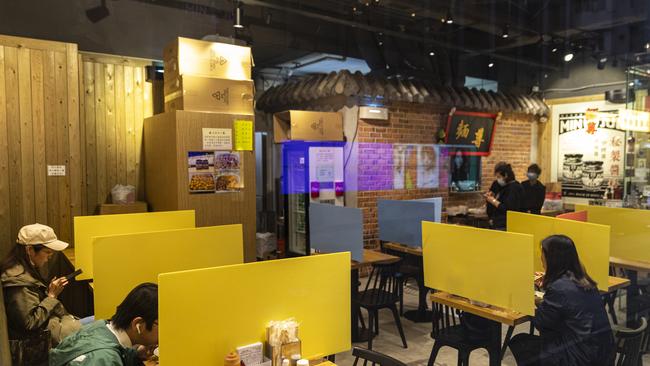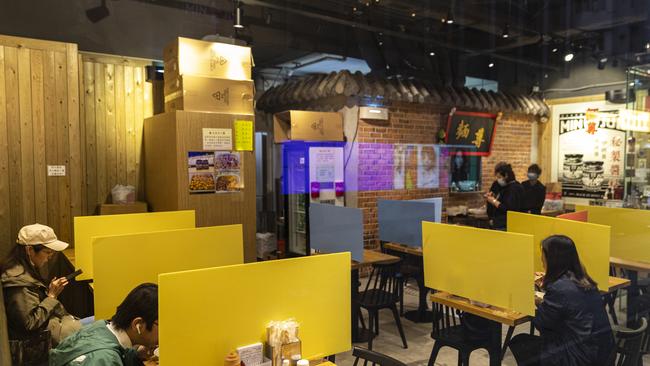Coronavirus: What restaurants could look like after COVID-19
Australians are waiting for the reopening of restaurants and pubs, but the NSW Premier says they won’t be open again soon.

Disposable menus, social distancing in waiting areas and partitions across tables could be the future of dining in Australia when restaurants re-open.
But another proposal, not submitted by Restaurants and Catering Australia, has been labelled “ill-advised” by the government.
The separate proposal would require diners, who do not have the CovidSafe app on their phone, to give the restaurant or cafe their name and number to help health authorities potentially track them down in the future.
Speaking on Today on Wednesday morning, NSW Premier Gladys Berejiklian would not give a date on when bars, restaurants, cafes and gyms would reopen.
“We don’t have a date for any of those things yet,” she said.
“We have a handful of new cases now every day, but back in March we were getting 200 cases a day. That would have made us like New York or Italy.
“Every time we take a step forward and ease a restriction, I don’t want to see us go backwards.
“In some countries when they haven’t planned as well, they have gone up and down, open, shut, open, shut, that doesn’t make businesses sustainable, certainly doesn’t provide certainty for families.
“What we want to do in NSW is have a staged approach where we ease restrictions, make sure the case numbers are manageable and do that as soon as possible, of course.”
Attorney-General Christian Porter told The Guardian he had concerns about the proposed guidelines to reopen restaurants.
“I read that proposition … I think that would be skating very close to the ice of being a requirement. That would be rather ill advised in the circumstances.”
Draft legislation on the CovidSafe app has already started to address restricting entry to people without the coronavirus tracing app.
Despite that proposal being slapped down by the government, Restaurant and Catering Australia has issued some promising reopening guidelines to National Cabinet, which include a series of “practical, low-cost measures” to get restaurants running again.
The measures include:
• 1.5-metre distance between tables
• All patrons must have the COVIDSafe app or record their name and number at the place they dine in so they can be contacted later if needed
• Social distancing in waiting areas
• Removing the limit on “tap and go” payments, having wipes available for patrons to wipe down the cash register keypad before use
• No condiments on tables
• Disposable or chalkboard menus, or laminated if they can be cleaned
• Commercial dishwashers that can sanitise cutlery and crockery to 80 degrees, or recyclable cutlery and crockery
• Hand sanitisers throughout the location
• Staff practising WHO and state/federal health guidelines – i.e. wiping down tables and chairs between each patron, no bar service
Some countries in East Asia, like China and Hong Kong, have already reopened their dining establishments with new post-COVID rules.
Photographs reveal just how different eating out could look when other countries get back to businesses.
GROUP DINING LIMITS
In Hong Kong and China, restaurants are required to keep the capacity below 50 per cent and restrict groups to a maximum of four people.
Australia has already put a similar rule in place, with a one-person-per-four-square-metres rule for all gatherings. When restaurants are permitted to re-open for dining in, this could be reduced to a 1.5-metre-distancing.
In Hong Kong, restaurant owners who disobey the rules can be fined as much as $HK50,000 ($A10,025).
Diners are also required to keep a 1.5-metre space between tables, which could mean a temporary design overhaul for some restaurants, with some tables barred or blocked off to ensure social distancing.

QR CODES TO ENTER ESTABLISHMENTS
In China, people have a personal QR code that must be scanned before they are allowed to enter an establishment, as part of a colour-based health code system.
Everyone is required to enter their personal information and answer a series of questions, including previous travel history. They are then issued either a green, orange or red colour. Gaining access into restaurants is determined by the colour of your code.
Australia has not implemented this exact system, but patrons could be made to record their name and phone number at a dining establishment, or have the COVIDSafe app downloaded on their phone, under Restaurant and Catering Australia’s proposal.

MANDATORY TEMPERATURE CHECKS
Some restaurants in Hong Kong and China also conduct mandatory temperature checks for both employees and diners entering and leaving an establishment.
Any diner who registers a fever will be turned away.
Australia has previously put some mandatory temperature checks in place, including for airport arrivals and at some pharmacies.
BARRIERS TO BLOCK TABLES
Many restaurants across Asia have put acrylic barriers in place since the start of the pandemic.
These screens effectively seal people off from one another to ensure the virus can’t spread.

WHEN WILL RESTAURANTS REOPEN IN AUSTRALIA?
Federal and state government talks remain under way for the reopening of restaurants and pubs – but it could still be a while off.
Principal Medical Adviser Professor Michael Kidd said talks were in place about possibly lifting some of the restrictions, but a slow and steady approach was needed to minimise further outbreaks.
“As you've mentioned, the National Cabinet is meeting twice this week, today and again later in the week, to talk about the possible lifting of some of the restrictions which are in place at the moment,” he told Today.
“What we do know is that, in order to prevent the sort of problems that you’ve been talking about with potential further outbreaks, any lifting of restrictions needs to happen in a careful and staged approach.
“I don’t want to pre-empt the decisions that the National Cabinet will make but we need to just wait and see when it is we’ll be able to return to some of those activities.”
The Northern Territory is an exception to this, having announced a “road map” to significantly wind back COVID-19 restrictions over the next month.
NT Chief Minister Michael Gunner released a detailed road map last Friday, which he called the “road map to the new normal”.
The plan will see cafes, bars and restaurants reopened on May 15 with two-hour limits, and a mandatory purchasing of food at pubs. After two weeks, the state will remove the time and purchasing limits if case numbers do not increase.
Queensland is chasing the green light to reopen dining establishments from June, with National Cabinet set to make a decision this Friday.
